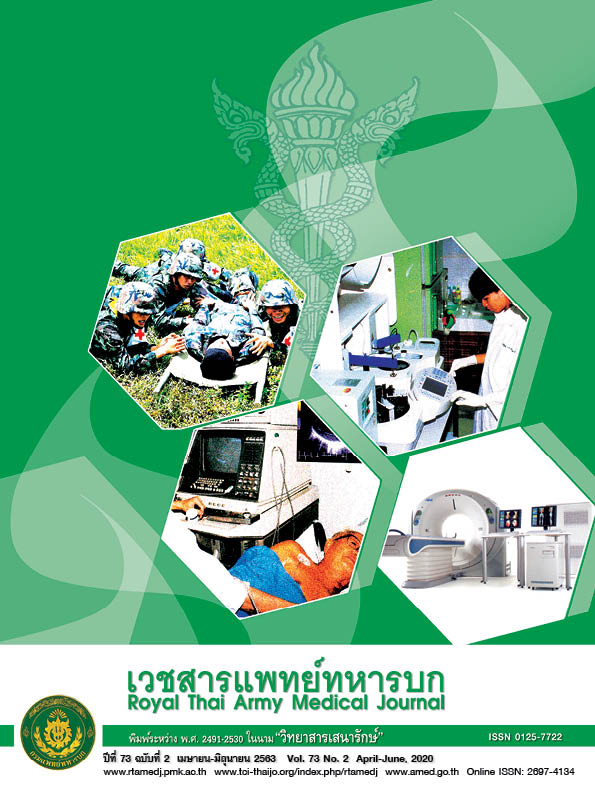Short Term Effects of Exercise Training by Assistive Teaching Exercise Program with Kinect Camera for Elderly on Balance Disorder Condition
Main Article Content
Abstract
Introduction: The elderly were at risk of the decrease in muscle mass and strength, and they were incapable of maintaining their balance resulting in the limitation of doing activities in daily life. Based on clinical practice guidelines, the exercise was one of the effective methods to solve these problems.
Objective: The purpose of this study was to compare the effect of an 8-week balance training Kinect-based exercise program in the elderly with fall risk.
Materials and Methods: Twenty-four subjects who have 60-69 years with fall risk were randomly divided into Control group (n=12) and Kinect group (n=12). The Kinect group performed exercise training 1 hour/times, 3 times/week for 8 weeks. Both groups were measured outcomes before exercise, 4 weeks, and 8 weeks after exercise training using body compositions (BIA analysis), clinical balance tests and muscular strength tests. Data were analyzed by using Mixed model ANOVA and Non-parametric tests. The significance was accepted at p<0.05.
Results: The Kinect group significantly improved balance ability more than the control group. It was also found that the Kinect group significantly increased the balance ability, speed of walking, and muscular strength of legs after 8 weeks exercise training.
Conclusions: The Kinect-based exercise program was effective for improving clinical balance ability, muscular strength of legs and increasing self-confidence in carrying out everyday activities with the risk of falling in the elderly after 8 weeks exercise training.
Downloads
Article Details
Articles in this journal are copyrighted by the Royal Thai Army Medical Department and published under the Creative Commons Attribution-NonCommercial-NoDerivatives 4.0 International (CC BY-NC-ND 4.0) license.
may be read and used for academic purposes, such as teaching, research, or citation, with proper credit given to the author and the journal.
Use or modification of the articles is prohibited without permission.
Statements expressed in the articles are solely the opinions of the authors.
Authors are fully responsible for the content and accuracy of their articles.
Any other republication of the articles requires permission from the journal.
References
2. Ministry of public health. Situation of the Thai elderly. 3rd ed. Bangkok: Foundation of Thai gerontology research and development institute; 2009.
3. Van Diest M, Stegenga J, Wortche HJ, Verkerke GJ, Postema K, Lamoth CJ. Exergames for unsupervised balance training at home: a pilot study in healthy older adults. Gait Posture. 2016;44:161–7.
4. Sherrington C, Michaleff ZA, Fairhall N, Paul SS, Tiedemann A, Whitney J, et al. Exercise to prevent falls in older adults: an updated systematic review and meta-analysis. BJSM. 2017;51(24):1750–8.
5. Moschny A, Platen P, Klaassen MR, Trampisch U, Hinrichs T. Barriers to physical activity in older adults in Germany: a cross-sectional study. IJBNPA. 2011;8:1-10.
6. Hsieh WM, Chen CC, Wang SC, Chen YL, Hwang YS, Lai JS. Combination of the Kinect with virtual reality in balance training for the elderly. J. Sci. Res. 2013;5:171–5.
7. Kitisomprayunkun W. Rehabilitation medicine. Bangkok: Chulalongkorn University printing house; 2013.
8. Boonsinsukh R. Balance control. Bangkok: Thai physical therapy clinic Publishing; 2012.
9. Patel NN, Pachpute S. The effects of Otago exercise programme for fall prevention in elderly people. IJPHY. 2015; 2(4):633-9.
10. Hill KD, Schwarz JA, Kalogeropolous AJ, Gibson SJ. Fear of Falling Revisited. Arch Phys Med Rehabil. 1996;77:1025-9.
11. Khongsri N, Tongsuntud S, Limampai P, Kuptniratsaikul V. The prevalence of sarcopenia and related factors in a community-dwelling elders Thai population. Osteoporos Sarcopenia. 2016;2(2):110–5.
12. Poncumhak P, Suwannaku B, Srithawong A. [Validity of five times sit to stand test for the evaluation of risk of fall in community-dwelling older adults]. Bull Chiang Mai Assoc Med Sci. 2559;2:236-44. Thai
13. Kwak CJ, Kim YL, Lee SM. Effects of elastic-band resistance exercise on balance, mobility and gait function, flexibility and fall efficacy in elderly people. J Phys Ther Sci. 2016;28:3189–96.
14. Paul S, Basu S, Nasipuri M. Microsoft Kinect in gesture recognition: a short review. IJCTA. 2015;8(5):2071-6.
15. Kaewkaen K, Uttama S, Ruengsirarak W. [Reliability of five-timed-sit-to-stand test by Kinect timed camera in young adults]. Srinagarind Med J. 2019;34(4):374-8. Thai
16. Bohannon RW, Shove ME, Barreca SR, Masters LM, Sigouin CS. Five-repetition sit-to-stand test performance by community-dwelling adults: a preliminary investigation of times, determinants, and relationship with self-reported physical performance. IES. 2007;15(2):77-81.
17. Sato K, Kuroki K, Saiki K, Nagatomi R. Improving walking, muscle strength, and balance in the elderly with an exergame using Kinect: a randomized controlled trial. Games Health J. 2015;4:161-7.
18. Hardy SE, Perera S, Roumani YF, Chandler JM, Studenski SA. Improvement in usual gait speed predicts better survival in older adults. JAGS. 2007;55(11):1727-34.
19. Mangione KK, Craik RL, McCormick AA, Blevins HL, White MB, Sullivan-Marx EM, et al. Detectable changes in physical performance measures in elderly African Americans. Phys Ther. 2010;90(6):921-7.
20. Mayer F, Scharhag-Rosenberger F, Carlsohn A, Cassel M, Müller S, Scharhag J. The intensity and effects of strength training in the elderly. Dtsch Arztebl Int. 2011;108(21):359-64.
21. Kirkendall DT, Garrett WE. The effects of aging and training on skeletal muscle. AJSM. 1998;26(4):598-602.
22. Cohen J. Statistical power analysis for the behavioral sciences. 2nd ed. New York: Taylor & Francis Inc; 1988.


